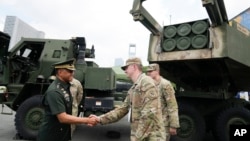A U.S. plan to deploy sophisticated missiles on a Japanese island chain close to Taiwan is prompting angry responses from both China and its close ally Russia.
The United States is drawing up a joint military plan with Japan to deploy High Mobility Artillery Rocket Systems (HIMARS) and other weapons to Japan’s Nansei Islands, according to a Sunday report by Kyodo News, which cited unnamed sources. The plan is expected to be completed by December.
The island chain stretches from Japan’s main islands to within 200 kilometers of Taiwan and includes Okinawa,which has a major U.S. military presence. The U.S. could use the missiles to defend Taiwan in case of a Chinese invasion of the self-ruled island, which Beijing claims as a renegade province.
The plan, the first joint operation by the U.S. and Japan to prepare for a war between Taiwan and China, will involve sending a U.S. Marine Corps regiment that possesses HIMARS and setting up temporary bases on the Nansei Islands to station them, said Kyodo. The Japan Self-Defense Forces would be expected to provide logistic support, including fuel and ammunition.
A Chinese foreign ministry spokesperson criticized the reported plan at a press conference on Monday, saying, “China opposes relevant countries using the Taiwan question as an excuse to strengthen military deployment in the region, heighten tensions and confrontation, and disturb regional peace and stability.”
Russian Foreign Ministry spokesperson Maria Zakharova responded with a stronger statement, warning that her country would respond to the deployment with “necessary and proportionate steps” to strengthen its defense capabilities, according to the Russian news agency Tass on Wednesday.
“We have repeatedly warned the Japanese side that if, as a result of such cooperation, U.S. medium-range missiles emerge on its territory, this will pose a real threat to the security of our country,” Zakharova said.
Tass also quoted Russian Deputy Foreign Minister Sergey Ryabkov urging Washington to reconsider the deployment of missiles to the Asia-Pacific. He warned that Moscow will not rule out stationing shorter- and intermediate-range missiles in Asia in response to the U.S. deployment.
Earlier in November, Russian President Vladimir Putin said China is Russia’s ally and “Taiwan is part of China,” and that China conducting wargames near the island is “a completely reasonable policy” while Taipei is escalating tensions.
While Russia and China have no formal military treaty, Putin and Chinese leader Xi Jinping have spoken of having a “no limits” partnership, and the United States accuses China of supporting Russia’s war efforts against Ukraine.
U.S. Secretary Antony Blinken said at a press conference held at the G7 meeting in Italy on Tuesday that China’s support for Russia’s defense industry is “allowing Russia to continue the aggression against Ukraine.”
US-Japan missile plan
Despite Moscow’s alarming rhetoric, analysts say the deployment of HIMARS to the region is primarily aimed at protecting Taiwan from Chinese warships.
“The most important purpose of HIMARS” would be “an anti-ship capability” and to “protect the island and base itself,” said Michael O’Hanlon, a senior fellow at the Brookings Institution.
Navy Adm. Samuel Paparo, commander of the U.S. Indo-Pacific Command, said last week at a forum held by the Brookings Institution that China this past summer conducted its largest rehearsal to date for an invasion of Taiwan involving 152 vessels. He cautioned that the U.S. “must be ready.”
The Chinese People’s Liberation Army (PLA) Navy possesses the world’s largest naval force with over 370 ships and submarines while the U.S. has about 290 vessels.
Eye on Chinese invasion
Timothy Heath, senior international defense researcher at the RAND Corp., said HIMARS on the Nansei islands “could help sink amphibious landing ships as well as destroyers and other PLA Navy ships that might approach the island from the north” and also “target concentrations of PLA troops on beaches near Taipei.”
Heath continued, “The fielding of these weapons systems shows that the U.S. and its allies are learning lessons from the Ukraine theater, where HIMARS have been effectively deployed against Russia.”
The U.S. is also planning to deploy the Multi-Domain Task Force’s (MDTS) long-range firing units to the Philippines, said Kyodo news on Sunday. The MDTS uses HIMARS as long-range firing units.
“The deployment of HIMARS to Nansei islands and long-range firing units to the Philippines will impose greater costs on China,” said Ryo Hinata-Yamaguchi, an associate professor at Tokyo International University Institute for International Strategy and a nonresident senior fellow with the Atlantic Council’s Indo-Pacific Security Initiative.
“Both locations are vital to deter China’s aggressive moves in not only the Taiwan Strait and East China Seas, but also Beijing’s ambitions in the Pacific. Still, one can expect China to do more to outdo such measures by enhancing their military readiness and conducting more assertive activities in the coming years,” he said.
Taiwan and the Philippines, as well as Japan and Indonesia, make up what China calls the first island chain potentially blocking its military access to the Pacific.
U.S. Defense Secretary Lloyd Austin concluded a nine-day trip to the Indo-Pacific on Monday after a series of meetings with the defense heads of countries in the region, including Japan, the Philippines, Australia and South Korea.
At the meetings, Japan agreed to increase its participation in annual trilateral amphibious training with the U.S. and Australia. The Philippines agreed to share military intelligence by signing a General Security of Military Information Agreement (GSOMIA) with the U.S.







